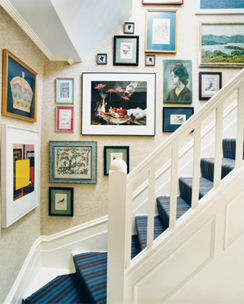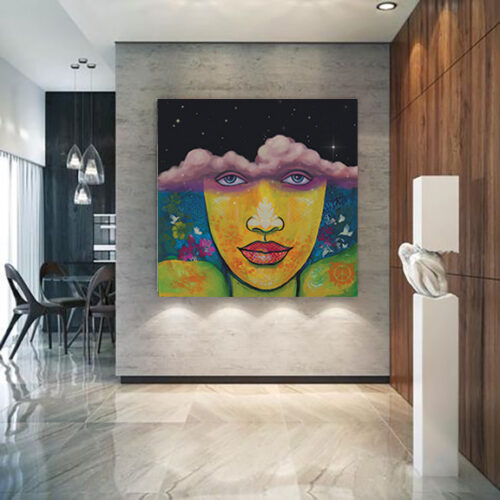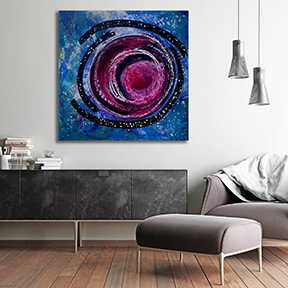So you’ve finally found the perfect artwork for your home – you’ve searched for paintings to buy online, placed your order, and all that’s left to do is unwrap your canvas and hang your new art!
Even if the piece you’ve chosen is already wonderful, it’s important to hang your art in a way that it looks great in your home. Here are a few tips for hanging your art like a pro!
To frame or not to frame?
This is a question that comes up a lot – should I have my art framed? If you are buying art that is coming unframed, then the choice is really up to you. We think both options look great! If you are choosing to have your art framed, plan accordingly so that you can get it up on your wall sooner than later.
If you have purchased a painting that is gallery-wrapped, that means the canvas is attached around the sides, and the sides are finished (painted) and are at least 1″ deep. In that case, it’s accepted that you don’t need to frame that painting. But as always, it’s up to you. Most galleries don’t frame gallery-wrapped paintings.
Hanging art relative to other objects in your home
Hang your painting at an average eye level.
We often hear from customers who are placing artwork in common places like above the fireplace, above the sofa or above a bed. Hanging art above furniture is a great way to anchor the art piece and add some interest to a room. There are certain ways to do this so that your new original painting or artwork looks its best.
In this case, the eye level rule may not necessarily apply, because you should be positioning your artwork relative to the object (for example, the fireplace mantle). Consider the space and the size of the items. A large painting above the bed might look great when it is positioned closer to the headboard, while a small painting would probably look better spaced further from the headboard.
Which orientation should I choose?
When it comes to hanging art by your furniture, the same level of consideration goes for the orientation of your art. A vertical painting will look best over a more narrow object like a fireplace mantel, whereas we typically see horizontal paintings hung above a longer piece of furniture like a sofa.
Hanging “gallery walls”
When you are creating a gallery wall, you’ll want to follow similar rules to the above. The difference is that you should treat the multiple pieces of art as a grouping. You can use one artwork as a focal point and build your gallery around it. Look at the entirety of your gallery wall as one unit, and position it accordingly.

Here are some more tips for hanging groupings of art:
- Plan Your Layout. Determine the place you want to hang your arrangement, and create a practice layout first. Try to have a focal point, either in the middle or off to one of the sides. Whether you lay the actual pieces on an open flat floor surface or cut paper shapes the size of your frames and hang them on the wall, be sure to try lots of different placements, turns and scenarios. This is the time to experiment with spacing and placement that you might not have considered before. If space is limited, try drawing the layout.
- Measure and Measure! These are not rules, but it helps to have some guidance. The general height and placement recommendation is to set the top of your lowest piece at 58 inches above the floor. As you add other artwork, leave two inches (or more, depending on the look you’re going for, just be consistent) around each frame on all sides. If there’s furniture against the wall you’re designing (say a lower sofa or buffet table), try placing the bottom of the lowest picture 6 to 8 inches above the top of the piece of furniture. Keep in mind that these are general recommendations – be sure to create your layout based on what’s best for YOU!
- Don’t Let It Fall! Always use two hooks or nails to keep frames stable on the wall, especially on large frames. Use heavy-duty anchors if a single piece is over about 40 pounds, otherwise two general hooks/nails per piece should suffice. Smaller frames, like 5×7 and 8×10 frames, could get by with one nail or hook in the center of the piece. Make sure you are using wire to hang the art and not some kind of sawtooth metal on the back from a craft store.
- Spacing is Important! You don’t have to measure. You can “eyeball” the space between the paintings quite easily. Just keep some distance of a minimum of 2″ between each painting on top, bottom and sides. Anything less than that will look unbearably cluttered to most peoples’ eyes.
This article is adapted from Zatista and other art hanging blogs






